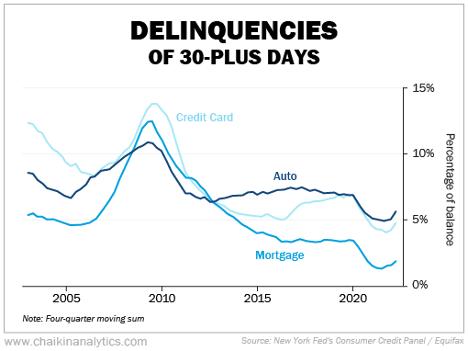
Inflation, Interest Rates, Debt Levels: The ‘Trinity of Trouble’ is Happening Right Now
This post is brought to you by our friends at Chaikin Analytics. Get Chaikin’s free e-letter PowerFeed here.
Folks, a dangerous combination is brewing beneath the surface. It’s what I like to call the “trinity of trouble.”
When inflation and interest rates rise together, it puts a strain on U.S. consumers. That’s happening today, of course. And it’s even worse when a third factor is rising.
Credit card balances are growing in the face of higher interest rates. And when inflation, interest rates, and debt levels all head in the same direction, things don’t usually end well. The problem is U.S. consumers are sometimes blind to the consequences of overleverage. Heck, even U.K. pension funds recently learned a lesson about leverage.
Some Wall Street observers may tell you that this problem is overblown. They would argue that wage growth will continue to move up and, as that happens, they expect consumer prices to return to previously normal levels. But that’s wishful thinking, at best.
The main issue is really simple. The markets need the American consumer to stay healthy. After all, U.S. household consumption accounts for roughly 70% of our gross domestic product. In the wake of the COVID-19 pandemic, U.S. consumers started to redeploy their spending. But there’s a dark side to this increased spending—surging debt levels.
Looking More Closely at Debt
Consider these factors:
Total household debt in the U.S. increased by $312 billion in the second quarter. Now, balances are more than $2 trillion higher than they were in the final quarter of 2019.A lot of people are using debt to buy things because prices have gone up so much. For example, the average dollar amounts of new homes and cars are bot up 36% from 2019.Wages aren’t keeping pace with inflation. The Economic Policy Institute showed that the 2021 national median income has increased a paltry 0.1% since 2019.
It’s clear that debt is increasing. People want to maintain their standard of living—inflation or not.
Credit card companies know what to do in this environment. They’ll raise interest rates to hedge against “delinquencies.” That’s the term for those who struggle to pay their bills on time. And delinquencies are already increasing. You can see what I mean by looking at the chart below of the New York Fed’s Consumer Credit Panel. It breaks down the percentage of consumers who are 30-plus days late on various types of loans.
You may notice, delinquency rates are nowhere near the 2008 crisis peak yet. But any uptick in this environment is dangerous. The Consumer Financial Protection Bureau (“CFPB”) is on alert as well.
In 2021, the CFPB noted that the difference between the prime rate and the average rate on credit cards was at record highs. And back then, delinquencies were at record lows. So, if the CFPB was worried about rising credit-card rates back then, it’s probably even more concerned today.
Our takeaway is simple. The trinity of trouble is brewing beneath the surface. Delinquencies are starting to creep higher at a time when we’re living with rising inflation and interest rates. It’s wishful thinking at best if you think this problem will just fix itself. It’s becoming clearer that things may not end well.
Good investing,
Pete Carmasino
Chief Market Strategist, Chaikin Analytics
P.S. Remember to mark November 15, on your calendar. At 10 AM ET, stock market expert Marc Chaikin will be sharing an important market warning.
In short, what he says that morning could cause thousands of investors to move out of cash and popular stocks. Instead, many of them may turn to a rare new vehicle that could have helped them double their money 63 different times after the 2020 crash.
This special online briefing is free for all StockCharts.com subscribers. We only ask that you reserve your spot in advance. Click here for full details.
This article was originally posted in October 2022 on ChaikinPowerFeed.com.
